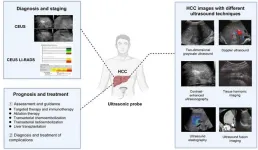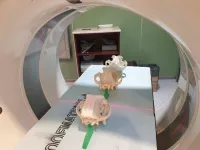(Press-News.org)
Hepatocellular carcinoma (HCC) is a primary malignancy of the liver and one of the leading causes of cancer-related deaths worldwide. Early detection and accurate diagnosis are crucial for effective management and improved survival rates. Ultrasound (US) technology has significantly advanced and plays a pivotal role in the surveillance, diagnosis, and treatment of HCC. This paper delves into various ultrasound techniques and their clinical applications in HCC management.
Two-dimensional gray-scale ultrasound is a fundamental imaging technique for HCC surveillance. It is widely used due to its non-invasive nature, cost-effectiveness, and convenience. This technique provides real-time images of the liver, enabling the detection of liver nodules and other structural abnormalities. Regular monitoring with gray-scale ultrasound is recommended for high-risk patients, including those with cirrhosis, chronic hepatitis B or C infections, and a family history of HCC. Studies have shown that consistent surveillance can lead to early detection of HCC, which is associated with a significant survival benefit.
Doppler ultrasound techniques, including color Doppler flow imaging, color Doppler energy, and advanced modes like super microvascular imaging, are essential for evaluating the vascular characteristics of HCC. These methods visualize blood flow within the tumor and its periphery, aiding in the assessment of tumor vascularity and invasion. Color Doppler ultrasound provides critical information for therapeutic decisions, such as identifying suitable vessels for transarterial chemoembolization (TACE).
Contrast-enhanced ultrasound (CEUS) represents a significant advancement in liver imaging. By administering contrast agents, CEUS enhances the visualization of blood flow and tissue perfusion in liver lesions. This technique is instrumental in the preoperative diagnosis, guided biopsy, intraoperative navigation, and post-treatment monitoring of HCC. CEUS is preferred over traditional imaging modalities due to its superior accuracy and lack of radiation exposure. Additionally, three-dimensional CEUS (3D-CEUS) provides detailed spatial visualization of tumor vascularity, further improving diagnostic precision.
Tissue harmonic imaging enhances the quality of ultrasound images by utilizing harmonic frequencies generated by tissue interaction with ultrasound waves. This technique improves the resolution and contrast of images, making it easier to distinguish between HCC and benign liver lesions. Tissue harmonic imaging is particularly useful in patients with fatty liver disease or other conditions that degrade conventional ultrasound image quality.
Ultrasound elastography measures tissue stiffness, providing additional diagnostic information about liver lesions. It is particularly effective in distinguishing between benign and malignant tumors, as HCC typically exhibits increased stiffness compared to surrounding liver tissue. Elastography can be integrated with other ultrasound techniques to enhance the accuracy of HCC diagnosis and monitor the response to treatment.
Ultrasound fusion imaging combines real-time ultrasound with other imaging modalities like CT or MRI, allowing for synchronized and correlated images. This technique offers a comprehensive view of the liver, integrating structural and functional information. Ultrasound fusion imaging is beneficial for precise localization and characterization of liver lesions, guiding biopsies, and planning therapeutic interventions. The ability to display multiplanar reconstruction images on a single screen facilitates quicker and more accurate clinical decision-making.
Ultrasound is the cornerstone of HCC surveillance programs. Regular ultrasound screening in high-risk populations, such as patients with cirrhosis or chronic viral hepatitis, significantly reduces mortality by enabling early detection and timely treatment of HCC. The sensitivity and specificity of ultrasound for HCC detection vary depending on the patient’s risk factors, the operator’s expertise, and the quality of the equipment used. Continuous advancements in ultrasound technology aim to improve the effectiveness of HCC surveillance and ultimately enhance patient outcomes.
Advancements in ultrasound technology have revolutionized the diagnosis and management of hepatocellular carcinoma. Techniques such as two-dimensional gray-scale ultrasound, Doppler ultrasound, contrast-enhanced ultrasound, tissue harmonic imaging, ultrasound elastography, and ultrasound fusion imaging each offer unique advantages that enhance the detection, characterization, and treatment of HCC. Continued research and development in these areas hold promise for further improving the accuracy and efficacy of HCC management, ultimately leading to better patient outcomes.
Full text
https://www.xiahepublishing.com/2310-8819/JCTH-2024-00018
The study was recently published in the Journal of Clinical and Translational Hepatology.
The Journal of Clinical and Translational Hepatology (JCTH) is owned by the Second Affiliated Hospital of Chongqing Medical University and published by XIA & HE Publishing Inc. JCTH publishes high quality, peer reviewed studies in the translational and clinical human health sciences of liver diseases. JCTH has established high standards for publication of original research, which are characterized by a study’s novelty, quality, and ethical conduct in the scientific process as well as in the communication of the research findings. Each issue includes articles by leading authorities on topics in hepatology that are germane to the most current challenges in the field. Special features include reports on the latest advances in drug development and technology that are relevant to liver diseases. Regular features of JCTH also include editorials, correspondences and invited commentaries on rapidly progressing areas in hepatology. All articles published by JCTH, both solicited and unsolicited, must pass our rigorous peer review process.
Follow us on X: @xiahepublishing
Follow us on LinkedIn: Xia & He Publishing Inc.
END
Democrats and Republicans overestimate the percentage of people in the opposing party who approve of widely agreed-upon moral wrongs, such as theft or animal abuse, according to a study. Today, Americans hate their opposing political party more than they love their own party, and political animosity and dehumanization of opposing party members have been on the rise for decades. Curtis Puryear and colleagues looked for a “basic morality bias” in social media posts from 5,806 political partisans by searching for words that referencd ...
Mohammad Atari and colleagues explore the promise and peril of using large language models (LLMs) in psychological research, beginning by urging researchers to also ask themselves whether and why they should use LLMs—not just how they should use them. The authors caution against using LLMs as a replacement for human participants, noting that LLMs cannot capture the substantial cross-cultural variation in cognition and moral judgement known to exist. Most LLMs have been trained on data primarily from WEIRD (Western, Educated, Industrialized, Rich, Democratic) sources, disproportionately in English. Additionally, although ...
Large language models (LMs) can complete abstract reasoning tasks, but they are susceptible to many of the same types of mistakes made by humans. Andrew Lampinen, Ishita Dasgupta, and colleagues tested state-of-the-art LMs and humans on three kinds of reasoning tasks: natural language inference, judging the logical validity of syllogisms, and the Wason selection task. The authors found the LMs to be prone to similar content effects as humans. Both humans and LMs are more likely to mistakenly label an invalid argument as valid when the semantic content is sensical and believable. LMs are also just as bad as humans at the Wason selection task, in which the participant ...
A study combining history, economics, and fluvial geomorphology examines the causes of the adoption of coal power during the Industrial Revolution in Great Britain. At the beginning of the mechanization of the textile industry in Britain, most machines were powered with waterpower. Eventually waterpower was replaced by using coal to make steam power and the causes of this shift have long been debated. One influential hypothesis has been that waterpower became scarce in the industrial heartland of northwest England during the early 19th century, as all available suitable sites were already fitted with ...
Industrial emissions are one of the main sources of climate change-inducing carbon dioxide (CO2). While adopting renewable and clean energy alternatives is one option for mitigating these carbon emissions, carbon capture technology is another solution to control CO2 emissions. In big CO2-emitting industries, such as cement, oil refineries, and thermal power plants, carbon capture technology can be easily applied to remove CO2 emissions directly at the source at a feasible cost and with low energy consumption. Different materials have been explored for CO2 capture in factories, including zeolites, metal−organic frameworks, natural minerals, alkalis, ...
The ELTE Eötvös Loránd University is home to the skulls of more than 150 dog breeds and other animals. To make this unique collection accessible to all, researchers digitised the skulls of 431 dogs, cats and wild relatives. The database can be used for educational and research purposes.
Tibor Csörgő, a researcher at ELTE, has been collecting animal skulls for decades to teach anatomy to biologists. The shape of the skull varies considerably between species and breeds, especially in dogs, where, for example, greyhounds have long skulls and the now popular French bulldogs have rounded skulls.
A skull biobank ...
Overcoming Historical Barriers
Silicon, the cornerstone of modern electronics, photovoltaics, and photonics, has traditionally been limited to surface-level nanofabrication due to the challenges posed by existing lithographic techniques. Available methods either fail to penetrate the wafer surface without causing alterations or are limited by the micron-scale resolution of laser lithography within Si. In the spirit of Richard Feynman's famous dictum, 'There's plenty of room at the bottom', ...
Preeclampsia (PE) is a significant contributor to the increase in maternal morbidity and mortality worldwide, with particularly alarming numbers in the United States, where it affects about 2–8% of pregnancies, resulting in premature birth with associated morbidities for their infants as well. A new study by researchers at UCLA Health finds that early detection of specific microRNAs (miRNAs) packaged in vesicles may offer the opportunity to predict preeclampsia in pregnant people before clinical symptoms manifest.
The study, led by Dr. Sherin U. Devaskar, MD, executive chair of the Department of Pediatrics ...
Researchers from the Qingdao Institute of Bioenergy and Bioprocess Technology (QIBEBT) of the Chinese Academy of Sciences have developed low-cost micro-sized silicon anodes from recycled photovoltaic waste using a novel electrolyte design.
Their pioneering work, published in Nature Sustainability on July 16, offers a path to more sustainable, low-cost, and high-energy-density batteries that could transform energy storage systems for electric vehicles and renewable energy applications.
Silicon anodes are favored for their ability to substantially increase the energy density of lithium-ion batteries compared to traditional graphite anodes but are hindered by significant volume ...
Billions of dollars in foreign aid could be spent more effectively if international poverty statistics were more accurate, according to new research led by King's College London.
Dr Michail Moatsos, a research fellow in the Department of International Development, says current methods for calculating the international poverty line lead to a skewed picture of how poverty is distributed across the world – and this is hampering attempts to eradicate it.
“Currently, international donors cannot prioritise their funds based on the best possible information and therefore funnel those funds to those most in need around the world. A $2.15 per day poverty line affords very different ...






